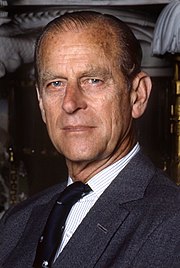Douglas is a common surname of Scottish origin, thought to derive from the Scottish Gaelic dubh glas, meaning "black stream". There are numerous places in Scotland from which the surname is derived. The surname has developed into the given name Douglas. Douglas is a habitational name, which could be derived from any of the many places so-named. While there are numerous places with this name in Scotland, it is thought, in most cases, to refer to Douglas, South Lanarkshire, the location of Douglas Castle, the chief stronghold of the Lords of Douglas. The Scottish Gaelic form of the given name is Dùbhghlas[ˈt̪uːl̪ˠəs̪]; the Irish-language forms are Dúghlas and Dubhghlas, which are pronounced [ˈd̪ˠuːɣlˠəsˠ]. According to George Fraser Black, in southern Argyllshire the surname is an Anglicised form of the surnames MacLucas, MacLugash.

Gordonstoun School is a co-educational independent school for boarding and day pupils in Moray, Scotland. It is named after the 150-acre (61 ha) estate owned by Sir Robert Gordon in the 17th century; the school now uses this estate as its campus. It is located in Duffus to the north-west of Elgin. Attendance is subject to an interview plus references and exam results. It is one of the last remaining full boarding schools in the United Kingdom.

The title Duke of Abercorn is a title in the Peerage of Ireland. It was created in 1868 and bestowed upon James Hamilton, 2nd Marquess of Abercorn. Although the Dukedom is in the Peerage of Ireland, it refers to Abercorn, West Lothian, and the Duke also bears four titles in Peerage of Scotland and two in the Peerage of Great Britain, and is one of only three peers who have titles in those three peerages. The Duke of Abercorn also claims the French title of Duke of Châtellerault, created in 1548.

James VI and I was King of Scotland as James VI from 24 July 1567 and King of England and Ireland as James I from the union of the Scottish and English crowns on 24 March 1603 until his death in 1625. The kingdoms of Scotland and England were individual sovereign states, with their own parliaments, judiciaries, and laws, though both were ruled by James in personal union.

Earl of Selkirk is a title in the Peerage of Scotland, used since 1646. It has rules of inheritance subject to unusual and unique provisions.

Duke of Hamilton is a title in the Peerage of Scotland, created in April 1643. It is the senior dukedom in that peerage, and as such its holder is the premier peer of Scotland, as well as being head of both the House of Hamilton and the House of Douglas. The title, the town of Hamilton in Lanarkshire, and many places around the world are named after members of the Hamilton family. The ducal family's surname, originally "Hamilton", is now "Douglas-Hamilton". Since 1711, the Dukedom has been held together with the Dukedom of Brandon in the Peerage of Great Britain, and the Dukes since that time have been styled Duke of Hamilton and Brandon, along with several other subsidiary titles.

Earl of Huntingdon is a title which has been created several times in the Peerage of England. The medieval title was associated with the ruling house of Scotland.

The Mountbatten family is a British dynasty that originated as an English branch of the German princely Battenberg family. The name was adopted on 14 July 1917, three days before the British royal family changed its name to “Windsor”, by members of the Battenberg family residing in the United Kingdom, due to rising anti-German sentiment among the British public during World War I. The name is a direct Anglicisation of the German Battenberg, or Batten mountain, a small town in Hesse. The titles of count and later prince of Battenberg had been granted in the mid-19th century to a morganatic branch of the House of Hesse-Darmstadt, itself a cadet branch of the House of Hesse.

The title of Earl of Inverness was first created in 1718 in the Jacobite Peerage of Scotland, together with the titles Viscount of Innerpaphrie and Lord Cromlix and Erne, by James Francis Edward Stuart for the Honourable John Hay of Cromlix, third son of the 7th Earl of Kinnoull. He was created Duke of Inverness in 1727, but both titles became extinct upon the death of the grantee in 1740.
Norton Louis Philip Knatchbull, 3rd Earl Mountbatten of Burma, known until 2005 as Lord Romsey and until 2017 as The Lord Brabourne, is a British peer.

The Treaty of Union is the name usually now given to the treaty which led to the creation of the new state of Great Britain, stating that the Kingdom of England and the Kingdom of Scotland were to be "United into One Kingdom by the Name of Great Britain". At the time it was more often referred to as the Articles of Union.

Clan Douglas is an ancient clan or noble house from the Scottish Lowlands.
The International Best-Dressed Hall of Fame List was founded by fashionista Eleanor Lambert in 1940 as an attempt to boost the reputation of American fashion at the time. The American magazine Vanity Fair is currently in charge of the List after Lambert left the responsibility to "four friends at Vanity Fair" in 2002, a year before her death.
James Hamilton may refer to:
Honouring individuals with burials and memorials in Westminster Abbey has a long tradition.

Alexander Douglas Douglas-Hamilton, 16th Duke of Hamilton, 13th Duke of Brandon is a Scottish nobleman and the premier peer of Scotland.
Andrew Stewart, 2nd Lord Ochiltree fought for the Scottish Reformation. His daughter married John Knox and he played a part in the defeat of Mary, Queen of Scots at the battle of Langside.













